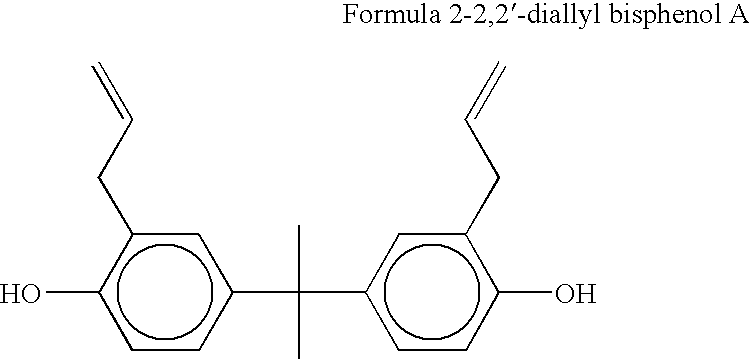Bismaleimide resin system with improved manufacturing properties
a resin system and resin technology, applied in the field of bismaleimide resins, can solve the problems of epoxy pmcs that cannot be used in extreme environments, application requirements that require higher thermal durability of finished composites, and limitations of pmr-15, so as to improve the viscosity of resins, improve thermal durability, and reduce the effect of viscosity
- Summary
- Abstract
- Description
- Claims
- Application Information
AI Technical Summary
Benefits of technology
Problems solved by technology
Method used
Image
Examples
example 1
[0070]The following experiment evaluated the amount of crystals that were formed by replacing the diallyl ether of bisphenol A of the present invention for the traditional 2,2′-diallyl bisphenol A mixed with bis(propenylphenoxy) ether of a substantially aromatic radical and slurry mixed in a particulate bismaleimide resin such as MDA-BMI powder.
[0071]A first formulation of a prior art resin formulation was made by adding 50 grams of 2,2′-diallyl bisphenol A at 80° F. Next, 50 grams of 4,4′-(2-propenylphenoxy) benzophenone (TM123) was preheated at 170° F. and mixed into the resin. The temperature of the resulting liquid resin mixture was increased to 200° F. Next, 100 grams of bismalelimide particles (MDA-BMI) was slurry mixed into the liquid resin mixture. The resulting slurry mixed resin mixture was cooled to room temperature.
[0072]A second formulation of the present invention was made by adding 50 grams of diallyl ether of bisphenol A at 80° F. Next, 50 grams of 4,4′-(2-propenylph...
example 2
[0077]The viscosity and tack of prepregs made using a prior art system, a modified version of a prior art system and the present invention were evaluated to compare the viscosity and tack of a final prepreg made from each.
[0078]A first formulation was made based on the prior art system by adding 74.87 grams of 2,2′-diallyl bisphenol A (Matrimid 5292B marketed by Huntsman) at 190° F. in an aluminum mixing can. Next, 0.6 grams of 1,4-napthaquinone was mixed into the resin. Next, 224.53 grams 4,4′-(2-propenylphenoxy) benzophenone (TM123) was mixed into the resin. The resin was 100% homogenous and dissolved. The resin was cooled to room temperature.
[0079]Room temperature (27° C.) viscosity was measured on the uncured neat resin using a ARES-3 rheometer with the following settings: parallel plate, 25 mm diameter plates, 0.5 mm gap, frequency of 10 rad / s. strain of 50% and time of 10 minutes. The room temperature viscosity was 100,000 poise.
[0080]The resin was stored at room temperature f...
example 3
[0087]Elevated temperature, thermal durability tests were performed on composites based on the present invention as well as the prior art system to demonstrate that while the tack and viscosity of the present invention are superior to the prior art system, there is no loss in thermal durability performance.
[0088]A first comparative formulation was made based on the prior art by adding 134.7 grams of 2,2′-diallyl bisphenol A (Matrimid 5292B) resin at 190° F. to an aluminum mixing can. Next, 1.2 grams of 1,4-napthaquinone was mixed into the resin. Next, 404.1 grams of 4,4′-(2-propenylphenoxy) benzophenone (TM123) was mixed into the resin. The resin is 100% homogenous and dissolved at this stage. Next, 660 grams of 20 μm particle size BMI (90% of particles less 20 μm in size) was slurry mixed into the resin. The resin is cooled to room temperature.
[0089]The finished resin system was coated onto silicone coated release paper and used to prepare a carbon / graphite prepreg.
[0090]A laminate...
PUM
| Property | Measurement | Unit |
|---|---|---|
| temperature | aaaaa | aaaaa |
| temperature | aaaaa | aaaaa |
| wt % | aaaaa | aaaaa |
Abstract
Description
Claims
Application Information
 Login to View More
Login to View More - R&D
- Intellectual Property
- Life Sciences
- Materials
- Tech Scout
- Unparalleled Data Quality
- Higher Quality Content
- 60% Fewer Hallucinations
Browse by: Latest US Patents, China's latest patents, Technical Efficacy Thesaurus, Application Domain, Technology Topic, Popular Technical Reports.
© 2025 PatSnap. All rights reserved.Legal|Privacy policy|Modern Slavery Act Transparency Statement|Sitemap|About US| Contact US: help@patsnap.com



